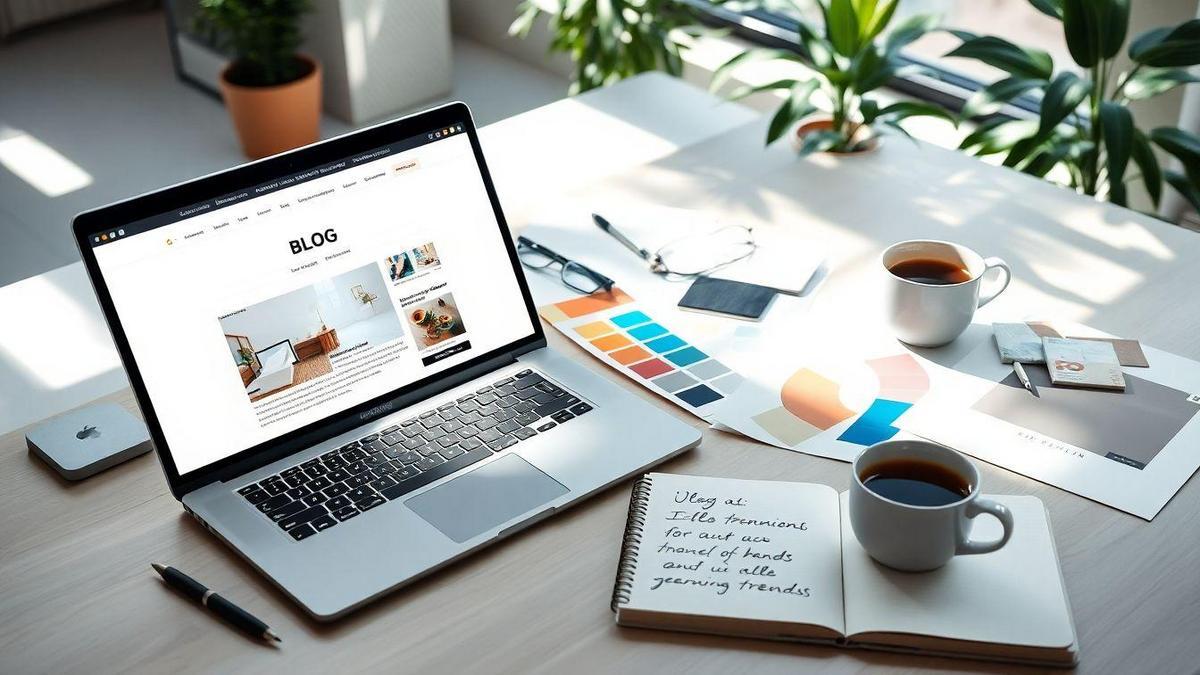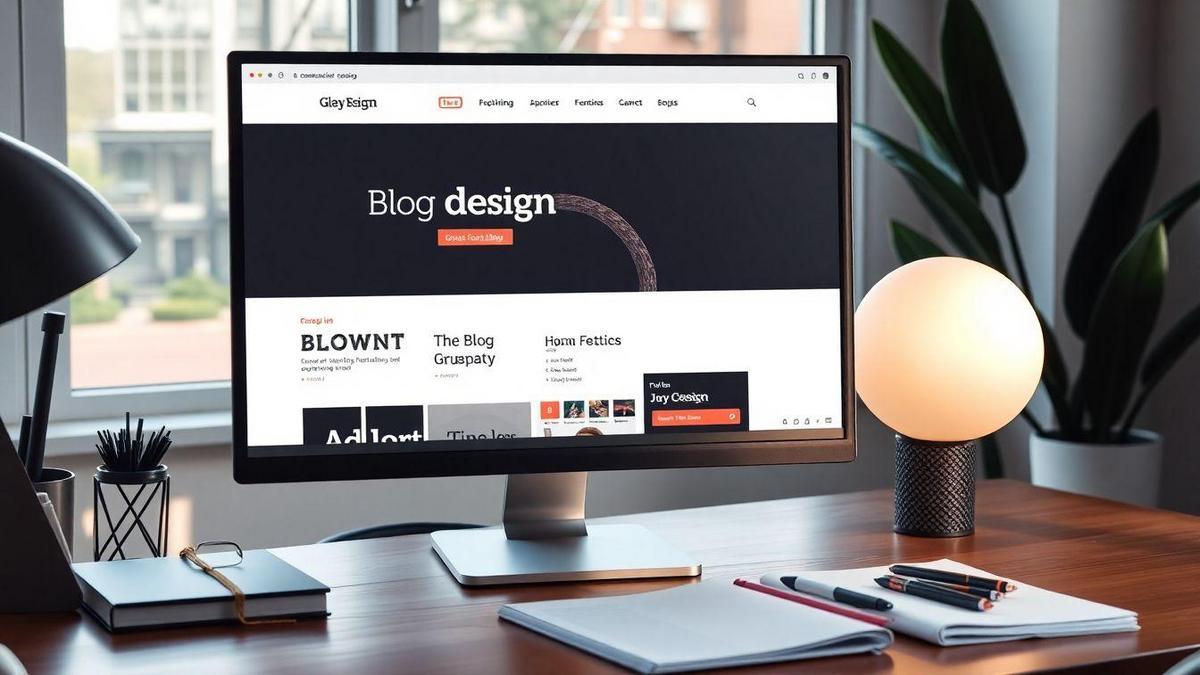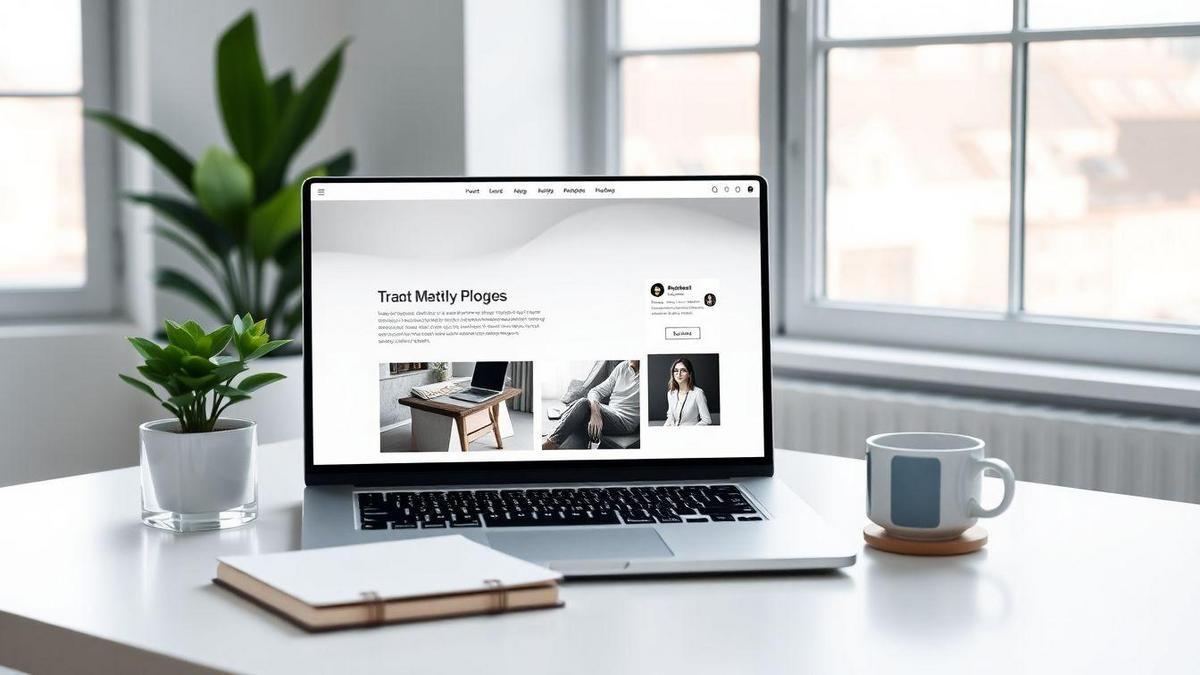Best UI/UX trends for modern blogs is what this article is all about! You’ll dive into how to make your blog stand out and create a great user experience. Are you ready to learn about clean designs, engaging interactivity, and mobile-friendly layouts? With tips on fonts, colors, and making your blog inclusive, you’ll be all set to catch your readers’ eyes. Get excited to explore trending ideas that will keep your blog fresh and fun!

Understanding the Best UI/UX Trends for Modern Blogs
What Makes a Great User Experience?
A great user experience (UX) is all about making your visitors feel at home on your blog. Imagine walking into a cozy café; you want a warm welcome, easy seating, and tasty treats. Your blog should feel just like that! Here are some key points that can help:
- Speed: If your blog takes forever to load, visitors will bounce faster than a rubber ball! Aim for quick loading times.
- Mobile-Friendly: More people are browsing on their phones. Make sure your blog looks good on any device.
- Easy Navigation: Keep menus simple and straightforward. Readers should find what they want without scratching their heads.
- Clear Call-to-Action: Want readers to subscribe, comment, or share? Make those buttons pop!
Key Elements of UI Design Inspiration
When it comes to UI design, inspiration is everywhere. Think of it like a treasure hunt! Here are some elements you might want to consider for your blog:
| Element | Description |
|---|---|
| Color Scheme | Use colors that reflect your brand and evoke emotions. |
| Typography | Choose fonts that are easy to read and match your style. |
| Imagery | High-quality images can capture attention and tell a story. |
| Whitespace | Don’t be afraid of empty space! It helps to keep things neat. |
Why User Experience Best Practices Matter
User experience best practices are like the golden rules of blogging. They help you keep your readers happy and coming back for more. When you follow these practices, you’re not just throwing spaghetti at the wall to see what sticks. You’re crafting an experience that resonates with your audience.
Think about it: if your blog is easy to read and navigate, visitors will spend more time exploring. This can lead to more shares and subscribers. It’s like planting a seed that grows into a beautiful tree of loyal readers!
The Power of Minimalist Blog Layouts
Benefits of Keeping It Simple
When it comes to blog design, less is often more. A minimalist layout can do wonders for your blog. Here are some benefits of keeping it simple:
- Faster Load Times: A clean design usually means fewer elements to load. This helps your page open quickly, keeping visitors happy.
- Better User Experience: With a straightforward layout, your readers can find what they want without getting lost in clutter.
- Focus on Content: A minimalist design directs attention to your writing. It allows your words to shine and your message to come through loud and clear.
- Easier Maintenance: Simple designs are often easier to update. You won’t have to spend hours tweaking elements that don’t need changing.
How to Create a Clean Design
Creating a minimalist blog layout doesn’t have to be rocket science. Here are some easy tips to get you started:
- Choose a Simple Color Palette: Stick to two or three colors that complement each other. This keeps your blog looking fresh and clean.
- Use Plenty of White Space: Don’t be afraid of empty space! It helps your content breathe and makes it easier to read.
- Limit Fonts: Pick one or two fonts and use them consistently. This adds to the overall harmony of your blog.
- Prioritize Navigation: Make sure your menu is easy to find and understand. A straightforward navigation bar helps visitors find their way around.
- Focus on High-Quality Images: Use images that add value to your content. Avoid adding too many visuals that might distract readers.
Examples of Successful Minimalist Blogs
Here are a few blogs that nail the minimalist design:
| Blog Name | Features | Why It Works |
|---|---|---|
| Minimalist Baker | Simple layout, clear navigation | Easy to find recipes and info |
| Zen Habits | Clean typography, lots of white space | Focuses on content, no distractions |
| The Good Trade | Soft colors, well-organized sections | Inviting and easy to read |
These blogs show how a minimalist approach can create a great user experience. They’re perfect examples of how simplicity can lead to success.

Interactive Elements That Engage Readers
What Are Interactive Elements?
Interactive elements are features on your website that let visitors engage actively instead of just passively reading. Think about things like quizzes, polls, videos, or even comment sections. These elements let you and your readers have a conversation. They can be fun and informative, making your blog feel more alive and connected.
How They Improve User Engagement
When you add interactive features, you’re not just throwing in some bells and whistles. You’re creating a dynamic experience that keeps visitors on your page longer. Here’s how they help:
- Boosts Attention: People love to click and explore. When they can interact, they’re more likely to stay and absorb your content.
- Encourages Sharing: Fun quizzes or polls can be shared easily on social media, pulling in more readers.
- Gathers Feedback: You get to know what your audience likes and dislikes, which helps you tailor your content better.
Here’s a quick look at how interactive elements can change the game:
| Benefits | Impact on Engagement |
|---|---|
| Keeps visitors longer | Reduces bounce rates |
| Sparks conversations | Builds community |
| Collects data | Improves content strategy |
Tips for Adding Interactive Features to Your Blog
Ready to spice things up? Here are some simple tips to add interactive features:
- Use Polls and Quizzes: Create fun quizzes related to your topic. This not only entertains but also informs you about your audience’s preferences.
- Incorporate Videos: Videos can explain complex ideas simply. Add a short video to break up your text and keep things lively.
- Enable Comments: Encourage your readers to share their thoughts. Responding to comments can create a sense of community.
- Add Call-to-Actions: Use buttons that invite your readers to take action, like signing up for a newsletter or sharing your post.
By weaving these interactive elements into your blog, you’re not just sharing information; you’re creating a space for connection and growth.
Responsive Web Design Trends for All Devices
Why Responsiveness Is Key
In today’s fast-paced digital world, responsiveness is crucial. You want your website to look great on any device, whether it’s a smartphone, tablet, or desktop. If your site isn’t responsive, visitors may bounce away faster than you can say user experience.
Think about it: you’re scrolling through your phone, and a site is all jumbled up. Frustrating, right? A responsive design keeps your content neat and tidy, making it easy for users to find what they need. Plus, Google loves mobile-friendly sites, so you get a boost in search rankings too!
How to Make Your Blog Mobile-Friendly
Making your blog mobile-friendly isn’t rocket science. Here are some simple steps to get you started:
- Use a Responsive Theme: Choose a theme that automatically adjusts to different screen sizes.
- Optimize Images: Make sure your images are not too big. They should load quickly and look sharp on all devices.
- Simplify Navigation: Keep your menu simple. Use dropdowns or a hamburger icon to save space.
- Test Your Content: Make sure your text is readable on smaller screens. Use larger fonts and plenty of white space.
Tools for Testing Responsiveness
You don’t have to guess if your site is mobile-friendly. Here are some handy tools to help you test responsiveness:
| Tool Name | Description |
|---|---|
| Google Mobile-Friendly Test | Check if Google thinks your site is mobile-friendly. |
| Responsinator | See how your site looks on different devices. |
| BrowserStack | Test your site on various browsers and devices. |
These tools will help you spot any issues and make necessary changes to keep your blog looking sharp.

Typography in Blog Design: Choosing the Right Fonts
Importance of Readable Fonts
When you’re designing your blog, readability is key. You want your readers to enjoy your content without straining their eyes. Fonts that are too fancy or too small can make it tough for folks to stick around. Think of it like this: if your words are like a warm hug, unreadable fonts are like a prickly sweater. You want your audience to feel cozy and comfortable as they read.
Here are some tips for choosing readable fonts:
- Size Matters: Aim for at least 16px for body text. This makes it easy for everyone to read.
- Simple is Better: Stick to clean and straightforward fonts. They are easier on the eyes.
- Contrast Counts: Make sure your text stands out against the background. Dark text on a light background or vice versa works best.
Pairing Fonts for Better Design
Now, let’s talk about pairing fonts. Mixing fonts can create a beautiful design, but it can also go south quickly if you’re not careful. The trick is to find a balance. You want your headers to stand out but not shout at your readers.
Here are a few tips for pairing fonts:
- Limit Your Choices: Use a maximum of two to three fonts. Too many can confuse your audience.
- Match Styles: Pair a serif font with a sans-serif font. This combo often looks great together.
- Hierarchy is Key: Make sure your header font is bolder and larger than your body font. This helps guide your readers through your content.
Popular Font Combinations for Blogs
Here’s a handy table of popular font combinations you might want to try:
| Header Font | Body Font |
|---|---|
| Montserrat | Open Sans |
| Playfair Display | Lato |
| Raleway | Roboto |
| Oswald | Arial |
| Merriweather | Source Sans Pro |
These combinations are like peanut butter and jelly—perfect together! They add personality to your blog while keeping it easy to read.
Color Schemes That Attract Attention
How Colors Affect User Experience
Colors play a huge role in how people feel when they visit your website. Think about it: when you see a bright, warm color, it can make you feel happy and energized. On the flip side, cool colors can bring a sense of calm and trust. For example, blue often makes people feel safe, while red can spark excitement or urgency.
When you choose colors for your website, you’re not just picking what looks good—you’re also influencing how users interact with your content. A well-thought-out color scheme can guide visitors’ emotions and actions, helping them stay longer on your site and engage more with what you have to offer.
Choosing the Right Color Palette
Picking the right color palette can feel like a tall order, but it doesn’t have to be! Here are some tips to help you nail it:
- Know Your Brand: What feelings do you want your visitors to have? If you’re a fun, playful brand, go for bright colors. If you’re more serious, stick to neutral tones.
- Limit Your Colors: Too many colors can confuse your visitors. Stick to 2-3 main colors and a couple of accent colors.
- Consider Contrast: Make sure your text stands out against the background. If it’s hard to read, people will bounce off your site faster than you can say goodbye!
Here’s a simple table to help you visualize different color combinations:
| Color Pairing | Vibe |
|---|---|
| Blue & White | Trustworthy & Clean |
| Red & Yellow | Energetic & Bold |
| Green & Brown | Natural & Earthy |
Tools for Creating Color Schemes
Want to whip up a stunning color scheme? There are plenty of tools out there to help you. Here are a few popular ones:
- Adobe Color: This tool lets you create color palettes and see how they look together.
- Coolors: A super easy color scheme generator that helps you find the perfect match.
- Canva Color Palette Generator: Upload an image, and this tool will extract colors from it, giving you a palette that suits your style.
These tools make it easier to find the right colors without pulling your hair out. Just play around, and you’ll find something that feels right!

Accessibility in Blog UX: Making Your Blog Inclusive
What Is Web Accessibility?
Web accessibility means making your blog easy for everyone to use, including people with disabilities. It’s about removing barriers that might stop someone from reading your content. Think of it like opening the door wide so everyone can come in. This includes those who might use screen readers, have trouble seeing colors, or need to navigate with a keyboard instead of a mouse.
Tips for Making Your Blog Accessible
Here are some simple tips to help you make your blog more accessible:
- Use Alt Text for Images: Always add a description to your images. This helps those using screen readers understand what’s in the picture.
- Choose Readable Fonts: Stick to clear, simple fonts. Avoid fancy styles that might confuse readers.
- Color Contrast: Make sure there’s a strong contrast between your text and background colors. This makes it easier to read.
- Headings and Structure: Use headings (like H2 and H3) to break up your content. This helps readers scan your blog quickly.
- Keyboard Navigation: Ensure that all parts of your blog can be accessed using just a keyboard. This is crucial for users who can’t use a mouse.
- Descriptive Links: Instead of saying click here, use descriptive phrases like read more about accessibility. This tells readers where the link will take them.
Here’s a quick table summarizing these tips:
| Tip | Description |
|---|---|
| Use Alt Text for Images | Describes images for screen readers. |
| Choose Readable Fonts | Use simple fonts for better readability. |
| Color Contrast | Ensure text and background colors contrast strongly. |
| Headings and Structure | Break content into sections for easier scanning. |
| Keyboard Navigation | Make sure everything is accessible via keyboard. |
| Descriptive Links | Use clear phrases for links to inform readers. |
Staying Updated with the Best UI/UX Trends
Where to Find Design Inspiration
Finding design inspiration can feel like searching for a needle in a haystack. But don’t worry! There are plenty of places where you can discover fresh ideas for your projects. Here are a few go-to spots:
- Pinterest: A treasure trove of visuals. Just type in what you’re looking for, and you’ll find endless ideas.
- Dribbble: This is where designers showcase their work. You can see the latest styles and get inspired by others.
- Behance: Similar to Dribbble, but with a wider range of creative fields. You can explore projects and connect with other designers.
Following Design Blogs and Resources
Staying updated with the best UI/UX trends for modern blogs is crucial. Here are some blogs and resources you should check out:
| Blog/Resource | Focus Area |
|---|---|
| Smashing Magazine | Web design and development |
| A List Apart | Web standards and best practices |
| UX Design.cc | User experience insights |
These blogs share tips, trends, and real-life examples that can help you stay ahead of the game.
Keeping Your Blog Fresh with New Trends
Keeping your blog fresh is important. You want your readers to come back for more. Here are some tips to keep things lively:
- Update Your Content Regularly: Add new posts or refresh old ones with the latest trends.
- Engage with Your Audience: Ask for feedback and see what they want to read about.
- Experiment with New Formats: Try videos, infographics, or podcasts to mix things up.
By staying on top of the latest trends and engaging with your audience, you’ll keep your blog vibrant and relevant.

The Future of Modern Blog Design
Emerging Trends to Watch
The blogging world is buzzing with fresh ideas and styles. You might have noticed minimalist designs are all the rage. They keep things clean and easy to read. But that’s just the tip of the iceberg! Here are some trends you should keep an eye on:
- Dark Mode: Many users prefer a darker background, especially at night. It’s easier on the eyes and looks sleek.
- Micro-Interactions: These are small animations that respond to user actions. They make your blog feel alive!
- Voice Search Optimization: With smart speakers on the rise, thinking about how your blog sounds is key.
- Mobile-First Design: More people are browsing on phones than ever. Your blog needs to look great on smaller screens.
| Trend | Description |
|---|---|
| Dark Mode | A sleek, dark interface that’s easy on the eyes. |
| Micro-Interactions | Small animations that enhance user experience. |
| Voice Search Optimization | Making your blog friendly for voice searches. |
| Mobile-First Design | Prioritizing mobile users for better accessibility. |
How to Prepare for Changes in UI/UX
Staying ahead of the curve is crucial. Here’s how you can gear up for these changes in UI/UX:
- Stay Updated: Follow design blogs and forums. They’re treasure troves of information.
- Test Regularly: Get feedback from your readers. What do they like? What can be improved?
- Experiment: Don’t be afraid to try new layouts or features. Sometimes, a little risk pays off big!
Adapting Your Blog for Future Trends
Adapting your blog isn’t just about looks; it’s about functionality too. Here’s how you can make your blog future-ready:
- Use Responsive Design: This ensures your blog looks good on any device.
- Focus on Speed: A fast-loading blog keeps readers happy. Use tools like Google PageSpeed Insights to check your speed.
- Engage with Your Audience: Use polls or questions to involve your readers. They’ll love being a part of your blog’s journey!
Frequently asked questions
What are the Best UI/UX trends for modern blogs?
The Best UI/UX trends for modern blogs include minimalistic design, dark mode, and interactive elements. They make your blog look fresh and user-friendly.
How does minimalistic design help my blog?
Minimalistic design helps by focusing on essential content. It makes it easier for your readers to find what they want quickly.
What is dark mode, and why should I use it?
Dark mode is a color scheme that uses light text on a dark background. It’s easier on the eyes and can save battery life on mobile devices.
Can interactive elements improve user engagement?
Yes! Interactive elements like polls, quizzes, and comment sections keep visitors engaged. They encourage readers to spend more time on your blog.
How often should I update my UI/UX design?
Aim to update your design every 1-2 years. Staying current with the Best UI/UX trends for modern blogs helps attract and keep readers.

Lucas is a technical SEO expert who has optimized over 200 websites and managed Google AdSense and Ad Manager campaigns since 2016. At ReviewWebmaster.com, he shares strategies to boost organic traffic and monetize every single visit.
Types of articles he writes:
-
“How to Increase Your Blog’s RPM with Simple Tweaks”
-
“Technical SEO Checklist for WordPress Sites”
-
“Complete Beginner’s Guide to Google Ad Manager”
Why it works:
Lucas brings a confident, analytical, and performance-driven voice to the site — perfect for readers looking for actionable, results-oriented content.
